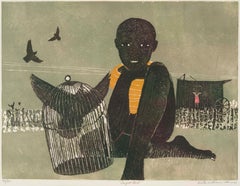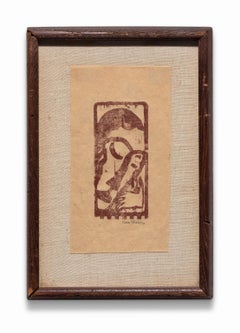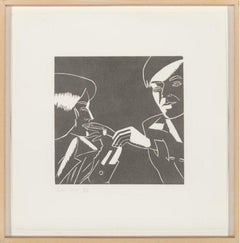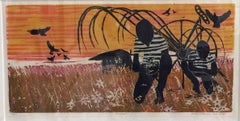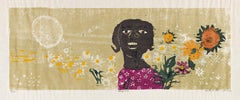Walter Henry Williams Prints and Multiples
to
1
Overall Width
to
Overall Height
to
1
1,183
938
886
817
1
1
1
1
1
1
1
1
1
1
1
Artist: Walter Henry Williams
CAGED BIRD
By Walter Henry Williams
Located in Portland, ME
Williams, Walter Henry (American 1920-1998). CAGED BIRD. Color woodcut, 1966. Edition of 210, signed, dated, titled and numbered 43/210 in pencil. 18 x 24 i...
Category
1960s Walter Henry Williams Prints and Multiples
Materials
Woodcut
Related Items
Max Weber Woodcut Print from "Primitives" Poetry Book Signed
By Max Weber
Located in Detroit, MI
ONE WEEK ONLY SALE
This woodcut print is an expressionist print on one of the poems from Max Weber's poetry collection "Primitives: Poems and Woodcuts". This work is signed in penci...
Category
1920s Expressionist Walter Henry Williams Prints and Multiples
Materials
Woodcut
Alex Katz from 'A Tremor in the Morning' signed, limited edition woodcut print
By Alex Katz
Located in San Rafael, CA
Alex Katz (b. 1927)
Untitled, from the portfolio 'A Tremor in the Morning', 1986
Woodcut on wove paper
Edition 32/45
Signed and numbered in pencil lower left
Sheet: 20 x 19.75 inches...
Category
1980s Contemporary Walter Henry Williams Prints and Multiples
Materials
Lithograph, Woodcut
$4,800
H 22.5 in W 22 in D 1.5 in
"Daikoku, Dieu de la Richesse" Japanese Style Woodblock Print
By Paul Jacoulet
Located in Austin, TX
A woodblock print of a Japanese geisha in elegant clothing against a yellow decorative background.
By Paul Jacoulet
15.5" x 12" Woodblock print on paper
Framed Size: 22.5" x 18.5"
...
Category
Mid-20th Century Walter Henry Williams Prints and Multiples
Materials
Paper, Woodcut
$2,500
H 15.5 in W 12 in
Untitled
By Kiki Smith
Located in New York, NY
Kiki Smith
'Untitled,' 1995
Woodcut with color additions by hand
31 x 21 inches
Edition 43 of 47
Signed
In 1995 five well-known American artists - Donald Baechler, Julian Lethbridge...
Category
1990s Walter Henry Williams Prints and Multiples
Materials
Woodcut
"Actor Kataoka Nazaemon as Oboshi Yaranosuke Leader of the 47 Ronin" Portrait
By Utagawa Kunisada (Toyokuni III)
Located in Austin, TX
Artist: Utagawa Kunisada "Toyokuni the Third" (Japanese 1786 - 1864)
Page Size: 14 x 9.5 in.
Frame Size: 21 x 16.25
Translation of Calligraphic Japanese Text:
大星由良之助 Ōboshi Yuranosu...
Category
Mid-19th Century Walter Henry Williams Prints and Multiples
Materials
Paper, Woodcut
Mountain Man with Bird
By Umetaro Azechi
Located in Austin, TX
UMETARO AZECHI
Title: Mountain Man and Bird
Medium: Woodblock Print
Measurements: 5 x 7 inches
Framing: Framed (12 x 13.44 inches)
Category
20th Century Walter Henry Williams Prints and Multiples
Materials
Woodcut
Paul Jacoulet Le Marie Seoul, Coriée, Woodblock Print, 1948
By Paul Jacoulet
Located in Austin, TX
Paul Jacoulet ( France, Japan 1902 - 1960 )
Title: La Mariée Seoul, Corée
Medium: Woodblock Print
Size: 15.5 in. x 12 in.
Movement: Showa
Markings: Si...
Category
1940s Walter Henry Williams Prints and Multiples
Materials
Woodcut
$2,800
H 15.5 in W 12 in
Nir Hadar, Woodstock
Located in Tel Aviv, IL
Hadar takes euphoric moments and try to generate a three dimensional feeling with every image inviting the viewer to jump into the game and to be part of it.
There's a hidden message...
Category
2010s Pop Art Walter Henry Williams Prints and Multiples
Materials
Woodcut
Nir Hadar, Fish and Chips, Print on wood or plexiglass
Located in Tel Aviv, IL
Hadar takes euphoric moments and try to generate a three dimensional feeling with every image inviting the viewer to jump into the game and to be part of it.
There's a hidden message...
Category
2010s Pop Art Walter Henry Williams Prints and Multiples
Materials
Plexiglass, Woodcut
French Woodcut - La Mer et Les Fleuves
By Colette Pettier
Located in Houston, TX
Absorbing black and white woodcut of a nude female figure in the water surrounded by sea life and small figures by French artist Colette Pettier, 1936. Signed, dated and numbered 49 ...
Category
1930s Walter Henry Williams Prints and Multiples
Materials
Paper, Woodcut, Ink
Violinist
Located in Berlin, MD
Engelina (Engelien) Reitsma-Valença (3 May 1889 - 11 July 1981) Amsterdam, Netherland. The portrait is of a violinist playing what appears to be an enervating piece. An engraver, st...
Category
Early 20th Century Art Deco Walter Henry Williams Prints and Multiples
Materials
Woodcut
Brutalist Graveside Scene Patriotic Dead Soldier, Gas Mask & Skeletons
By Nicholas Sperakis
Located in Exton, PA
Brutalist colored woodcut circa 1976 by Nicholas Sperakis. The image depicts skeletal figures around the grave of a soldier. Note the American flag features which drape the entombed ...
Category
1970s Expressionist Walter Henry Williams Prints and Multiples
Materials
Woodcut
$304 Sale Price
20% Off
H 38 in W 32 in D 1 in
Previously Available Items
HARVEST
By Walter Henry Williams
Located in Portland, ME
Williams, Walter Henry (American 1920-1998). HARVEST. Color woodcut, 1963. Edition of 210, signed, dated, titled and numbered 21/210 in pencil. 11 1/2 x 24 inches (image); 15 x 28 in...
Category
1960s Walter Henry Williams Prints and Multiples
Materials
Woodcut
Marguerite
By Walter Henry Williams
Located in New York, NY
Color linoleum cut on thin imitation Japan paper. Signed, titled, dated, inscribed "imp" and numbered 54/210 in pencil by Williams.
Pale marginal mat s...
Category
1960s Contemporary Walter Henry Williams Prints and Multiples
Materials
Color, Linocut
Walter Henry Williams prints and multiples for sale on 1stDibs.
Find a wide variety of authentic Walter Henry Williams prints and multiples available for sale on 1stDibs. You can also browse by medium to find art by Walter Henry Williams in linocut, woodcut print and more. Much of the original work by this artist or collective was created during the 1960s and is mostly associated with the contemporary style. Not every interior allows for large Walter Henry Williams prints and multiples, so small editions measuring 24 inches across are available. Walter Henry Williams prints and multiples prices can differ depending upon medium, time period and other attributes. On 1stDibs, the price for these items starts at $4,000 and tops out at $4,200, while the average work can sell for $4,100.
